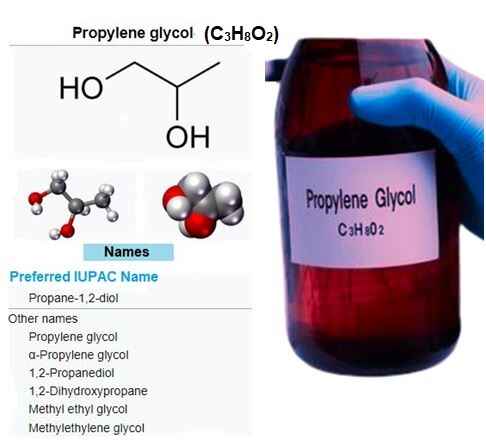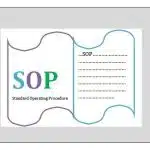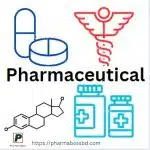Propylene glycol (PG) is a synthetic organic compound widely used in the pharmaceutical industry. It plays a significant role in various formulations due to its versatile properties, contributing to the effectiveness, stability, and safety of medications. This article delves into the significance, applications, safety, and potential concerns surrounding propylene glycol in pharmaceuticals.
Table of Contents

What is Propylene Glycol?
Propylene glycol (chemical formula: C₃H₈O₂) is a colorless, odorless, and hygroscopic liquid that is classified as a diol (a compound with two hydroxyl groups). It is produced through the hydration of propylene oxide, a petrochemical intermediate. As a highly stable and non-toxic substance, PG is widely used in various industries, including cosmetics, food, and pharmaceuticals.
Role of Propylene Glycol (PG) in Pharmaceuticals
Solvent and Vehicle: PG is primarily used as a solvent in pharmaceutical formulations, helping dissolve active pharmaceutical ingredients (APIs) that may not be water-soluble. It facilitates the creation of homogenous liquid formulations such as oral solutions, injectable, and topical products.
Humectant: Its hygroscopic nature allows PG to absorb moisture from the environment, making it an effective humectant. In topical creams and ointments, it helps maintain skin hydration by drawing moisture into the skin, enhancing the product’s moisturizing properties.
Stabilizer: PG is often added to pharmaceutical formulations as a stabilizer, ensuring the longevity and efficacy of the active ingredients. It can prevent the degradation of APIs caused by environmental factors like oxidation, heat, and light exposure.
Preservative: In addition to being a solvent, propylene glycol has mild antimicrobial properties, which help prevent the growth of microorganisms in liquid formulations. This characteristic is particularly beneficial for products with prolonged shelf lives, such as eye drops and oral syrups.
Emulsifier: PG serves as an emulsifying agent in various semi-solid and liquid formulations, helping to stabilize emulsions by preventing the separation of oil and water phases in products like creams and lotions.
Applications in Pharmaceutical Formulations
Propylene glycol’s unique properties make it indispensable in several pharmaceutical dosage forms:
Oral Formulations: PG is commonly used in oral solutions, syrups, and elixirs, where it acts as a solvent for active ingredients and flavoring agents. Its relatively non-toxic profile makes it suitable for ingestion, although there are limits on its concentration.
Injectable: In parenteral formulations, such as intramuscular or intravenous injections, propylene glycol serves as a solubilizing agent for drugs that are poorly soluble in water. However, its concentration is carefully regulated to avoid adverse effects, especially in sensitive populations.
Topical and Dermatological Products: PG is widely used in topical applications like creams, lotions, gels, and ointments due to its moisturizing and stabilizing properties. It enhances the skin’s permeability, allowing better absorption of the active ingredients in transdermal therapies.
Ophthalmic Preparations: In eye drops and ophthalmic ointments, PG acts as both a solvent and a preservative, ensuring the sterility and stability of the product over time.
Safety Profile of Propylene Glycol
PG is generally regarded as safe (GRAS) by the U.S. Food and Drug Administration (FDA) and is included in the FDA’s Inactive Ingredient Database for various pharmaceutical formulations. However, its safety and potential side effects depend on the dosage, route of administration, and the patient population.
Oral and Topical Use: In oral and topical formulations, PG is well-tolerated by most individuals. It is metabolized by the liver into lactic acid and pyruvic acid, both of which are further metabolized through normal biochemical pathways. However, in rare cases, individuals with sensitivity to propylene glycol may experience mild skin irritation or allergic reactions when used topically.
Parenteral Use: In injectable formulations, especially intravenous (IV) administrations, high concentrations of propylene glycol can lead to adverse effects like hemolysis, metabolic acidosis, and kidney dysfunction, particularly in infants, elderly patients, or individuals with compromised liver or kidney function. As a result, its use in parenteral products is carefully regulated and monitored.
Toxicity Concerns in High Doses: Propylene glycol toxicity is rare, but it can occur with excessive use or in vulnerable populations, such as preterm infants or patients with compromised metabolic functions. Symptoms of toxicity may include central nervous system depression, seizures, and lactic acidosis.
Regulatory Considerations
Due to its widespread use, regulatory authorities like the FDA, European Medicines Agency (EMA), and World Health Organization (WHO) have established guidelines for the use of PG in pharmaceuticals. Concentration limits vary based on the route of administration, and manufacturers must adhere to strict quality control measures to ensure product safety.
Potential Controversies and Alternatives
While propylene glycol is considered safe for most uses, concerns have been raised regarding its potential for causing allergic reactions and irritation in sensitive individuals. Some consumer groups advocate for the use of natural alternatives in products such as topical creams and cosmetics, prompting manufacturers to explore options like glycerin and plant-based solvents.
In recent years, there has been increasing interest in finding alternatives to PG in specific cases, especially for pediatric and geriatric populations or individuals with sensitivities. However, due to its wide range of applications and proven efficacy, propylene glycol remains a key component in pharmaceutical formulations.
Conclusion
Propylene glycol is a versatile and widely-used excipient in the pharmaceutical industry, playing a crucial role in enhancing the stability, efficacy, and usability of various medications. While generally safe for most people, it requires careful consideration in terms of dosage and application, particularly for injectable formulations. As pharmaceutical technology advances, ongoing research will continue to refine the safe and effective use of propylene glycol in medicine, ensuring that patient safety and product efficacy remain paramount.
Frequently Asked Questions (FAQs)
What is propylene glycol?
Propylene glycol is a synthetic organic compound with the chemical formula C₃H₈O₂. It is a colorless, odorless, tasteless liquid that is commonly used in a variety of industries due to its versatility and low toxicity. It has the ability to absorb water.
Why it used in pharmaceuticals?
In pharmaceuticals, it is used as a solvent, stabilizer, and preservative. It helps dissolve active ingredients, enhance their stability, and improve the overall texture and consistency of liquid medications, ointments, and creams.
Is propylene glycol safe to use in medications?
Yes, propylene glycol is considered safe for use in pharmaceuticals when used in regulated amounts. It is approved by the U.S. Food and Drug Administration (FDA) and other health authorities for use in oral, topical, and injectable medications. However, some people may experience allergic reactions or sensitivity to it, especially in large doses or prolonged exposure.
Can propylene glycol cause side effects?
While generally safe, propylene glycol can cause side effects in some individuals. In high concentrations, it may cause irritation, particularly in topical applications. When administered intravenously, large doses may lead to toxicity, especially in people with kidney or liver issues. Most people tolerate the small amounts used in medications well.
How is propylene glycol different from ethylene glycol?
Propylene glycol is often confused with ethylene glycol, but they are different substances. Ethylene glycol is toxic and used primarily as antifreeze, while propylene glycol is safe for use in food, cosmetics, and medications. Propylene glycol is classified as “generally recognized as safe” (GRAS) by the FDA, while ethylene glycol is harmful if ingested.
Related Topics:
Difference Between Water and Moisture Content

Abdus Sobhan Salim is professional experienced pharmacist in pharmaceuticals, author and founder of pharmabossbd.com, the first Bangladeshi pharmaceutical blogger since 2019.



